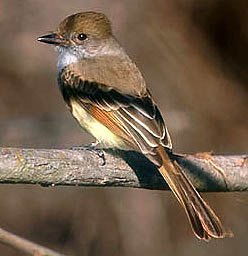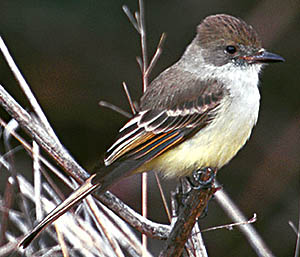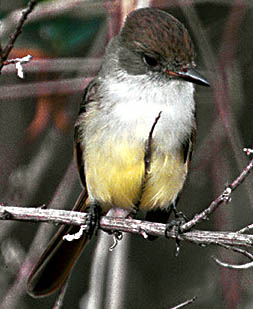Nutting's Flycatcher
Mason Regional Park, Irvine, California
22 December 2000
Joseph Morlan
Photographs © 3 February 2001 by Don DesJardin. All rights reserved. Additional
photos by David R. Ferry are below.
 Today, Robbie Fischer and
I visted Mason Regional Park off of Hillgate and Rockview in Irvine. We hoped to see a Harris's Sparrow which had
been found there yesterday by Bettina Eastman and Larry Tripp. When we arrived, we met Brian Daniels who informed
us that the "Dusky-capped Flycatcher" which had been seen in the area since 11 November 2000 may actually
be a Nutting's Flycatcher. He took us down to the far end of the park where a group of birders including Jim Pike
and Joel Weintraub were viewing the bird. However the flycatcher flew immediately landing in a bush in front of
me. Through binoculars I had serious doubts about this bird being a Dusky-capped Flycatcher. I noted a bill too
short and stout. It then flew into Mule Fat where I got brief views before it disappeared. Eventually the bird
was relocated by Maya Decker and Larry Tripp in an area in the undeveloped section of the park off Hillgate and
Maya let me view it through her scope. The flycatcher was mostly obscured by branches, but I could see some pale
on the lower mandible. However, I did not get a good look at the wing pattern or undertail. There was no visible
rusty on the upperside of the tail.
Today, Robbie Fischer and
I visted Mason Regional Park off of Hillgate and Rockview in Irvine. We hoped to see a Harris's Sparrow which had
been found there yesterday by Bettina Eastman and Larry Tripp. When we arrived, we met Brian Daniels who informed
us that the "Dusky-capped Flycatcher" which had been seen in the area since 11 November 2000 may actually
be a Nutting's Flycatcher. He took us down to the far end of the park where a group of birders including Jim Pike
and Joel Weintraub were viewing the bird. However the flycatcher flew immediately landing in a bush in front of
me. Through binoculars I had serious doubts about this bird being a Dusky-capped Flycatcher. I noted a bill too
short and stout. It then flew into Mule Fat where I got brief views before it disappeared. Eventually the bird
was relocated by Maya Decker and Larry Tripp in an area in the undeveloped section of the park off Hillgate and
Maya let me view it through her scope. The flycatcher was mostly obscured by branches, but I could see some pale
on the lower mandible. However, I did not get a good look at the wing pattern or undertail. There was no visible
rusty on the upperside of the tail.
 After a long period of time, Doug
Willick and I heard the bird calling low down near the first bridge. It gave a loud whistled "wheep"
recalling Brown-crested Flycatcher. We heard a few more calls indicating that the bird was ranging back to the
original spot at the northeast end of the park. Eventually the bird was relocated by Bettina, Robbie and others
and I was afforded excellent scope views thanks to Jim Pike's Kowa. There the bird called frequently and we watched
at close range as it fed on berries from ornamental shrubs.
After a long period of time, Doug
Willick and I heard the bird calling low down near the first bridge. It gave a loud whistled "wheep"
recalling Brown-crested Flycatcher. We heard a few more calls indicating that the bird was ranging back to the
original spot at the northeast end of the park. Eventually the bird was relocated by Bettina, Robbie and others
and I was afforded excellent scope views thanks to Jim Pike's Kowa. There the bird called frequently and we watched
at close range as it fed on berries from ornamental shrubs.
The following description is based on notes taken while watching the bird:
An obvious Myiarchus about the size and shape of Ash-throated Flycatcher, but with plumage somewhat
reminiscent of Dusky-capped Flycatcher. Underparts were bright yellow (but paler than on Dusky-capped) contrasting
with pale gray throat and chest. The yellow on the sides of the breast was shaded with grayish, extending narrowly
onto the flanks.
The upperparts were brown with an olive coloration occationally visible on the lower back and a warm rusty suffusion
on the uppertail coverts. The gray chest extended as a partial collar around the side of the neck, but did not
wrap all the way around. The brown back extended up the nape connecting to a brownish crest.
The ear-coverts were brown contrasting with the pale gray throat. The eye was brown with a very narrow grayish
eyering. Pale gray was also evident in the lores and forehead.
The wing pattern was quite complex. The primaries were all edged rusty on the outer webs, contrasting with yellow
edges on the outermost secondaries. This yellow coloration became rusty towards the bases of the secondaries. The
inner secondaries appeared to be edged in creamy whitish and the tertials edged in pale gray. The wing coverts
were edged in tan, forming faint wing-bars. The primary coverts were the same dark brown background color as the
rest of the wing.
The tail pattern was particularly well studied. The outermost rectrix (r6) was almost all dark on the underside
with only a small bit of rusty along the edge of the inner web. This caused the underside of the tail to look dark
when seen with the tail completely folded as shown in the accompanying photographs by Joel Weintraub. However the
rest of the rectrices were extensively rusty on the inner webs extending all the way to the tips of the feathers.
The tail thus showed considerable rusty above and below when spread or in flight.
The bill was dark, short and relatively stout, compared to similar species. As the bird called, the bright orange
mouth lining was evident. In good light, a pale line of pinkish appeared along the cutting edge of the bill and
some pale pinkish was evident at the base of the lower mandible. The legs were gray.
Around 3:30 pm, the bird starting calling incessantly, a loud "wheep" or "wheek" often with
a squeaky quality. Bettina Eastman obtained many useful recordings of the call while we watched the bird. It called
30-40 times during this period. Prior to this observation the bird called only infrequently.
Discussion
Key features which identify this bird as a Nutting's Flycatcher include the call, tail pattern, wing pattern,
mouth lining and bill shape. The call is somewhat similar to Brown-crested Flycatcher, although not as sibilant
and totally unlike any call given by Dusky-capped or Ash-throated Flycatcher. The tail pattern includes rusty extending
all the way to the tip of the central rectrices, eliminating Ash-throated Flycatcher; but the mostly dark outer
rectrices eliminate Brown-crested. Great-crested is eliminated by the pale throat, tail pattern, etc. The wing
pattern with the yellow fringed outer secondaries may be diagnostic for Nutting's Flycatcher although it has been
reported that adult Dusky-capped Flycatchers of some races may show a similar pattern. Further research is needed.
The orange mouth lining eliminates Ash-throated Flycatcher.
This is the second Nutting's Flycatcher I have seen. The first was at Lake Patagonia in Arizona. I have posted
some notes and useful links about that bird here. This
is the first record of Nutting's Flycatcher for California.
More information, including some wonderful photos of the spread tail, directions and maps to the area are available
here. Andy Birch
has posted some wonderful sketches here and Don
Roberson's account and photos are here.

Photos © 30 December 2000 by David R. Ferry |
 |
 After a long period of time, Doug
Willick and I heard the bird calling low down near the first bridge. It gave a loud whistled "wheep"
recalling Brown-crested Flycatcher. We heard a few more calls indicating that the bird was ranging back to the
original spot at the northeast end of the park. Eventually the bird was relocated by Bettina, Robbie and others
and I was afforded excellent scope views thanks to Jim Pike's Kowa. There the bird called frequently and we watched
at close range as it fed on berries from ornamental shrubs.
After a long period of time, Doug
Willick and I heard the bird calling low down near the first bridge. It gave a loud whistled "wheep"
recalling Brown-crested Flycatcher. We heard a few more calls indicating that the bird was ranging back to the
original spot at the northeast end of the park. Eventually the bird was relocated by Bettina, Robbie and others
and I was afforded excellent scope views thanks to Jim Pike's Kowa. There the bird called frequently and we watched
at close range as it fed on berries from ornamental shrubs. Today, Robbie Fischer and
I visted Mason Regional Park off of Hillgate and Rockview in Irvine. We hoped to see a Harris's Sparrow which had
been found there yesterday by Bettina Eastman and Larry Tripp. When we arrived, we met Brian Daniels who informed
us that the "Dusky-capped Flycatcher" which had been seen in the area since 11 November 2000 may actually
be a Nutting's Flycatcher. He took us down to the far end of the park where a group of birders including Jim Pike
and Joel Weintraub were viewing the bird. However the flycatcher flew immediately landing in a bush in front of
me. Through binoculars I had serious doubts about this bird being a Dusky-capped Flycatcher. I noted a bill too
short and stout. It then flew into Mule Fat where I got brief views before it disappeared. Eventually the bird
was relocated by Maya Decker and Larry Tripp in an area in the undeveloped section of the park off Hillgate and
Maya let me view it through her scope. The flycatcher was mostly obscured by branches, but I could see some pale
on the lower mandible. However, I did not get a good look at the wing pattern or undertail. There was no visible
rusty on the upperside of the tail.
Today, Robbie Fischer and
I visted Mason Regional Park off of Hillgate and Rockview in Irvine. We hoped to see a Harris's Sparrow which had
been found there yesterday by Bettina Eastman and Larry Tripp. When we arrived, we met Brian Daniels who informed
us that the "Dusky-capped Flycatcher" which had been seen in the area since 11 November 2000 may actually
be a Nutting's Flycatcher. He took us down to the far end of the park where a group of birders including Jim Pike
and Joel Weintraub were viewing the bird. However the flycatcher flew immediately landing in a bush in front of
me. Through binoculars I had serious doubts about this bird being a Dusky-capped Flycatcher. I noted a bill too
short and stout. It then flew into Mule Fat where I got brief views before it disappeared. Eventually the bird
was relocated by Maya Decker and Larry Tripp in an area in the undeveloped section of the park off Hillgate and
Maya let me view it through her scope. The flycatcher was mostly obscured by branches, but I could see some pale
on the lower mandible. However, I did not get a good look at the wing pattern or undertail. There was no visible
rusty on the upperside of the tail.

